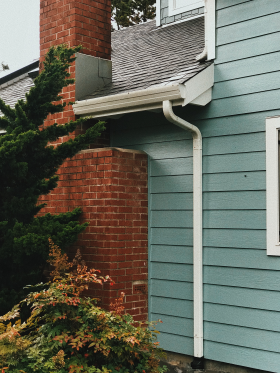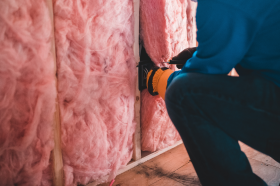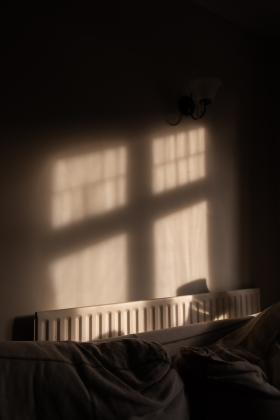Discount Code’s money-saving expert, Natalia Lachim, reveals how preparing our homes for Autumn can help reduce bills while still being able to heat our homes.
Clear your guttering
Although not the most glamorous of tasks, September is the ideal time for clearing gutters and checking for any potential damage. Clogged gutters, caused by a natural build-up of debris such as leaves, halts effective water drainage and can cause significant and costly damage to your property.
You can hire someone to come and do this for you, however, to save money it is simple to do this yourself, provided there isn’t significant damage and you feel comfortable doing so. All you will need is a sturdy ladder, an empty bucket, a small shovel and potentially a stiff brush for removing any stubborn leftovers. Once you scoop out as much of the debris as you can into the bucket, wash the gutters with a hose and use the brush to help loosen and remove anything stubborn leftover.
It may seem like a tiresome job but clearing your gutter at this turn of the season prevents potential flooding and damage to your property, especially as the weather will only get colder and windier once September ends.
Freeze-proof your pipes
Often overlooked in the build-up to autumn/winter but it is essential that your pipes are protected as the temperatures drop. If left to freeze, your pipes are more prone to freezing and can affect your water supply – not ideal in the middle of a particularly cold spell. Protecting pipes is simple and doesn’t need to cost too much money. Simply cover all pipes with foam insulation tubes, which can be found at local hardware stores. This simple trick will significantly reduce the risk of freezing and can help insulate the pipes when the heating is on.
Service the boiler
Ideally, the end of summer/early autumn is the best time to have your boiler serviced. Not only does this guarantee your boiler will be working efficiently in time for winter, but it is also the time when engineers are less busy, as people tend to leave this step until they encounter an issue with their boiler, once it is more in use.
Finding issues with your boiler early means it won’t break down when the weather turns. It is also advisable to get your boiler serviced before October, and before the rise in energy bill costs becomes our reality, as an un-serviced boiler will need to work harder and burn more fuel to heat your home, which will be much more costly once the price cap rises.
Finally, having your boiler serviced will increase the lifetime of your boiler, meaning you can prolong the need to fork out for an expensive new model.
Insulation on a budget
Insulation may seem an expensive investment, however, if you are on a budget, or if you are renting and can’t make any changes to your property, then there are DIY methods to help prevent heat from escaping and cold air from outside coming in. Check for gaps in window and door frames which may allow draughts in and out. If present, cover the gaps with draught stoppers to reduce the amount that’s able to move freely.
Also, have a look at other potential gaps that could allow air to move around. Check frequently overlooked areas such as keyholes, letterboxes and even pet flaps and see whether draughts are being allowed in through these areas.
It is worth noting, however, that while these changes are good for the short-term, in the long-term you should consider investing in your home’s insulation as this will go a long way in saving money and reducing your home’s carbon footprint. Insulating cavity walls and lofts and upgrading to double or triple glazing may be an investment but is worth the money.
Bleed your radiators
Especially after the record-breaking temperatures that most of the UK saw this summer, very few households will have turned their heating on in the last few months. Because of this, you may find that your radiator has air trapped inside, which will stop the warm water from circulating the radiator efficiently.
You will be able to tell if your radiator has air trapped inside if there are cold spots present on the radiator when it is switched on, or if the radiator takes much longer to turn on than it should. If this is the case, then you should bleed your radiator and get rid of the trapped air.
Can you keep your house warm without turning the heating on?
With energy bills reaching all-time highs, it is unsurprising that Google searches for ‘keep house warm without heating’ have seen an enormous 9900% uplift since the end of August, in anticipation of colder months. However, it is advisable to turn your central heating on in colder months for numerous reasons. Not only is it necessary and the best way to actually keep your home warm but leaving the heating off in particularly colder weather can lead to frozen pipes, which can then burst and create significant water damage in your home.
With an estimated 78% of Brits concerned about how much their energy bills will cost this winter, how can we keep costs down as much as possible without impacting our comfort indoors?
Home makeovers
This doesn’t have to be a big or expensive job, however, adding certain touches to your home can help your home retain heat more. The trend of ‘rug layering,’ which has seen an enormous surge of 8900% uplift in searches in the last month, involved piling a few rugs on top of each other, over wooden floors, thus insulating your home and preventing cold air from coming in.
Make the most of natural heat sources
Unfortunately, bright and sunny days are few and far between in colder months, however Autumn is the best time to make the most of the sunshine while it’s shining for longer. Around this time of year, it is advisable to skip the heating and instead open the windows when it’s warm outside to allow heat and light in.
Block up the chimney
If your autumn and winter evenings are spent curled up in front of the fire, then this won’t be one for you. However, as an estimated 2.5 million homes have a fireplace, with many not in use, this can amount for up to 30% of heat loss in winter, as warm air inside escapes. Blocking up the chimney doesn’t have to be a huge job and can be done on a budget. You can either cover the opening with bricks or plaster over it yourself.
By Natalia Lachim from Discount Code




